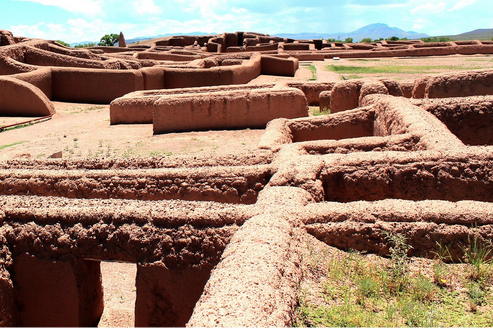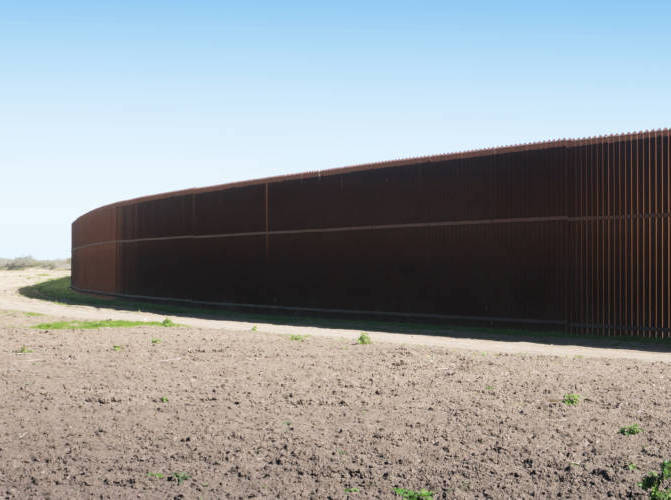

CASAS GRANDES, MEXICO
“We just ran over a snake,” says Eduardo Gamboa, as I steer my rental car along the rocky road leading to the Cueva de la Olla cliff dwellings, high in the Sierra Madre mountains. Summer monsoons here often force rattlers out of their normal habitats. True to the cliche, narrow paths really do define life and death in northwestern Chihuahua, Mexico.
The arid region’s unusual topography and weather — desert grasslands, sky islands (isolated mountain ranges with forests), snowy winters, and wet summers — make it a land of unique intersections, a place where physical extremes blur expectations. Native to the region are zone-tailed hawks, which confuse their prey by mimicking the appearance and flight patterns of nonpredatory turkey vultures.
A few miles out of Nuevo Casas Grandes, home to the storied Paquimé ruins and the main city in the vast agricultural area 170 miles southwest of El Paso, we pass trucks crowded with Mexican troops wearing black facemasks. The military, despite infiltration by the narcos, is often charged with policing the area. The government sees few alternatives. The entire police force of the nearby town of Ascencion, which reportedly serves as a cartel training camp, quit after being threatened by hitmen.
But the army is a blunt, often brutal instrument. Earlier this year, a judge sentenced the commander and seven soldiers from the 35th Infantry Battalion in Nuevo Casas Grandes to 33 years in prison for human rights violations, including torture, murder, and the clandestine burial of two civilians.
Gamboa, the classic-rock-loving lead archeologist of Paquimé, gives a musical explanation about his approach to the archeology of life and death in this mountainous desert region known for its brutal beauty and important historic sites. “As an archeologist, you have to be kind of crazy,” he says. “You have to have a wild side like the Lou Reed song talks about.”
These days, you have to be a little bit crazy to spend your time off-trail in this drought-ravaged part of the world. The drug wars have made forays inside and outside the cities and away from the tourist spots a potentially perilous undertaking. It’s been that way for nearly half a generation.
But now, there appears to be the beginning of a lasting lull in the violence, and with it a renewed interest in the archeology of the area, sites of tremendous importance to our understanding of the peoples — north and south — who called the area home and built the desert civilization that both Mexico and the United States have inherited.
This region is very much a crossroads — with the perpetual trafficking of humans and goods and the violence that comes with this transit. And it is hauntingly beautiful.
The mountains go from bald and arid to vibrant green within minutes of our ascent. “You can hear the diversity of the wild life in the names of some of the ranches around here: Stevens, Cave Valley, Joe Valley, El Willie,” Gamboa says. “These and other ranches were given American names by the Mormons who fled the US so they could keep their wild life going, polygamy.”
At the entrance to the Ignacio Zaragoza land cooperative where the Cueva de la Olla is located, we’re greeted by a woman whose family, Gamboa tells me, inherited the land from ancestors who fought for land rights and liberty alongside Pancho Villa during the Mexican Revolution. Considered a bandit by the Mexican and US governments, Villa remains a source of pride in Chihuahua, where traditional ballads celebrate the region’s long history of rebellion against Spanish, Mexican, and US authorities. It’s a history that’s still lived.
The woman at the gate greets Gamboa in the deferential tone reserved for the powerful. He is one of the lead archeologists of a ruin-rich region extending from the southern states of Zacatecas and San Luis Potosi all the way north to the US border. This gives him considerable influence, and we’re immediately waved in.
But there are always higher powers.
“Some narcos were just here,” the site manager reports when we reach the camp below the cave dwellings. “They brought their women and children like everybody else. But they were armed. After camping a few days, they left.” Even drug lords take breaks to enjoy the region’s beautiful sights with family and hitmen friends.
After so many decades of violent fighting for control over the multibillion-dollar desert and Sierra Madre smuggling routes, cartels and their sicarios, or assassins, have become a fact of life. A few may celebrate them as Villa-esque bandits — but everyone knows not to talk about their business.
We hike up to Cueva de la Olla, the most spectacular ruin of what locals call “Quebalé,” a word that some tourists think is indigenous but is actually a Spanish transliteration of “Cave Valley.” The cave and the large community of cliff dwellings were carved into the red volcanic tufa rocks by water — and later humans — over several millennia.
The view of the river, grass, and trees surrounded by the grainy volcanic cliffs housing other dwellings is grand. Outside, black vultures cruise the skies in search of carcasses on the scorching canyon floor. Inside, startled bats flit through the chilly air near the cave ceiling.
Just a few feet from the edge of the grotto are adobe dwellings that housed about 30 people, according to Gamboa, whose team has excavated and maintains the site. The cliff dwellings are impressive. But the most spectacular structure in the cave is the Cuexcomate, an 8-foot-tall, 12-foot-wide granary shaped like a gigantic pear.
The researchers discovered the remains of three bodies in a big room behind the Cuexcomate. “The people who lived here had the custom of burying their dead underneath their homes,” Gamboa says. “They kept their dead close. That funerary custom of burying your dead in your home or nearby is not exclusive to the Pueblo peoples. You find it throughout the continent.”
Two of the three skeletons belonged to the indigenous people who inhabited the dwellings. “But the third skeleton was strange,” he says. “We couldn’t figure out who it belonged to. It had a hole in the back of the cranium this big,” he says, using his hands to form a circle the size of a large plum. Cranial trauma in archeological and forensic investigations is among the most important indicators of violence.
“We analyzed the hole and realized it wasn’t made by the original inhabitants. They didn’t have .22-caliber pistols back then,” he says then pauses. “Somebody shot and then buried the body here centuries after it was last inhabited.”
Like archeologists working in Syria, Afghanistan, Colombia, and other regions in conflict, Gamboa and his colleagues must do archeology under complicated and often dangerous conditions. The land here has invisible lines drawn on it by very powerful parties: cartels, the government, and the security forces. All of the groups infiltrate one another, which makes the work of exploring and preserving northern Mexico’s rich archeological heritage an exercise in walking a very narrow, dangerous path.
Benito Juárez Avenue, the widest of the narrow, mostly paved roads leading from Nuevo Casas Grandes to nearby Casas Grandes — home to the Paquimé ruins — is barely wide enough for two cars along most of the 3-mile route. That’s why trucks, SUVs, and small vehicles rest on the side of the road loaded with maize, beans, apples, sorghum, and other products from the region. On the less-paved, less-traveled paths through the surrounding desert, people and vehicles are saddled with the more profitable crops: heroin, cocaine, methamphetamine, marijuana.
For every export, there’s an import. The drugs move north in exchange for the weapons and money moving south from the United States. It is a lifeline of illicit materiel to the two major armies battling for control of the routes — Joaquin “El Chapo” Guzman’s Sinaloa cartel and “La Linea,” the armed wing of the Juárez cartel. Many here believe that the region remains solidly under the control of the Sinaloa cartel, which authorities credit with between 5,000 and 6,000 homicides in Chihuahua in the past decade.
The aftermath of occasional skirmishes is evidence that the battle for control of the golden, multibillion dollar drug routes continues, but at a less bloody clip. In April, the bullet-riddled bodies of a La Linea capo and two of his sicarios were found in his truck.
That month, authorities launched the unironically named “Operation Safe Casas Grandes.” At a house near the quiet suburb and former Mormon community of Colonia Dublan, they found surface-to-air missiles, antivehicle sniper rifles, stolen sports cars, thousands of rounds of ammunition, drugs, and exotic animals, including three tigers, La Linea’s preferred mascot.
In Nuevo Casas Grandes, I was speaking with a local journalist who was supplementing his income by selling fruit on the side of the road when a group of sicarios decided to investigate what I was up to. The mysterious men had been sitting in a truck monitoring the comings and going from the town. When they saw me at the fruit stand, the two men in the front seats of the truck with tinted windows asked questions, while another man in the back held what looked like an AR-15 semiautomatic assault rifle. Satisfied, they then left us alone.
The Paquimé ruins nearby are an archeological wonder, uncovered thanks to the historic excavation led in the late 1950s and 1960s by Charles Di Peso.
Built by hundreds of workers moving mountains of water and tons of clay, the Paquimé complex has thousands of rooms, including an adobe apartment complex, colonnades, I-shaped ball courts, platform mounds, and other impressive structures reminiscent of the more monumental sites of Mesoamerica.
Gamboa calls the labyrinthine site the “center of the adobe universe.”
In archeological terms, the 88 acres of the Paquimé site — 27 times bigger than the famous Pueblo Bonito site in New Mexico’s Chaco Canyon — are the embodiment of in-betweenness, simultaneously the most important ruins in northern Mexico and arguably the most important site of the ancient indigenous cultures of the Southwestern United States. Ball courts, pens for macaws, and other elements of the Mesoamerican civilizations south of the Chihuahua desert fuse and intersect with adobe structures, T-shaped doors, and other Southwesternisms to give Paquimé its unique mixture of worlds.
Paquimé’s largest structure — the massive three- to seven-story adobe maze of rooms and buildings of the apartment — housed more than 3,000 people. The building, Gamboa says, reflects the influence of the “architectural legacy of the Mimbrenos,” pre-Columbian ancestors of the present-day Pueblo peoples of the Gila region in New Mexico. The massive apartment complex and other features of the site lead him and others to conclude that Paquimé’s origins lie in the north.
A mix of resource scarcity, violence, and climate change drove migration from the north to Paquimé, the opposite of the modern south-north migration dynamics in places like Syria, Central America, and the northern Mexico desert racked by resource scarcity, cartel violence, and human-influenced climate change.
Paquimé’s origin story and primary influences remain a source of a major archeological debate. Some, like the University of Denver’s Steve Lekson, expand on Charles Di Peso’s interpretation of it as a regional trade and religious center closely tied to Mesoamerica. Others, including Gamboa, see Paquimé as a southwestern site that’s largely a regional development where locals drew on both Mesoamerican influences from the south and Pueblo influences from the north.
“We prefer to call this Paquimé/Casas Grandes region the Northwest/Southwest,” says Elisa Villalpando, Gamboa’s colleague at Mexico’s National Institute of Anthropology and History. Villalpando is part of a large generation of intrepid female archeologists following in the footsteps of Beatriz Braniff, a legendary archeologist and first director of Paquimé following the Di Peso excavation. Villalpando is also the lead archeologist at the Cerro de Trincheras site, a terraced town located on a hill in the northern part of nearby Sonora state. “Though the connections are indisputable, you can’t explain everything with Mesoamerica. Paquimé also had relations with [communities in present-day] Nayarit, Sinaloa, Jalisco, and Sonora,” she says.
“Corridors of interchange in this region date back from before 1500 B.C.,” says Villalpando. The pre-Columbian peoples of these ancient corridors traded shells, turquoise, copper bells, macaws, and other items with other peoples to the north, south, and west. Today, some of these corridors are used as drug routes in states like Sinaloa, the birthplace of major cartel leaders, like El Chapo.
Archeologists digging for the past sometimes run across narcos in the field. Villalpando had her most serious encounter in 1997 during excavations near the Trincheras site, six hours’ drive west from Paquimé.
Villalpando faced opposition to her excavation from a group of narcos working for a leader of the Sinaloa cartel. Armed men came to the site, she said, to seize the area for their trafficking activities. “They said they were going to destroy the [archeological] site,” she tells me. “They threatened to kill my team and me because we were going to dig on a site they said belonged to a drug lord, a drug lord who said our work was not important.”
Villalpando did the one thing that likely saved both her team’s lives and the project — she started talking with the narcos. “We went to the media, we got a court injunction, we called on the federal government to protect us,” she says. “After several months, we reached an understanding that would respect our work. The drug lord came out on TV saying positive things about our project, even though he didn’t really want the attention.”
Over the years, other archeological digs in northern Mexico have also had encounters in the deserts, mountains, and oases of Chihuahua with the smugglers of drugs and people. However, no archeologists or tourists have been reported killed, even during the height of the violence, between 2006 when the drug war began and 2011 when some archeologists stopped their work entirely. The current violence in the region is largely limited to those directly involved in the drug trade.
For his part, Gamboa says a more direct impact on his work comes from how the drug war affects the budget of the National Institute of Anthropology and History. “Cueva de la Olla is already excavated, and we need money to install facilities to accommodate more people,” he says, “but there’s no money.” Similar shortages face Paquimé.
“We need money to fortify the site, which is very vulnerable because it is made of adobe. Rains can cause great damage, and for years we’ve been asking for resources to help, but there’s no money because . . . President [Enrique] Peña Nieto is using the money designated for education and culture to fight against protesting teachers and others opposed to his drug war.”
In terms of Chihuahua’s archeological tourism, Paquimé and northern Chihuahua’s biggest problem is one of perception. It is a perception of danger reinforced by US State Department travel warnings that Gamboa and most interviewed for the story agree are the biggest discouragement at a time when violence has been greatly reduced.
In the past decade, US tourism has plummeted. Of the 6,255, visitors to Paquimé last July, 5,967 were Mexican, according to museum statistics. Prior to the intensification of the drug war, busloads of US visitors accounted for about a quarter of the visitors.
But change may be coming with the end of monsoon season.
“It seems like pretty safe time to go down there” says Tim Maxwell, a retired archeologist and director emeritus at the New Mexico Office of Archaeological Studies.
Maxwell, who worked in Chihuahua for many years, led a tour to Paquimé this month, which he started organizing after violence declined. Reports from Mexican colleagues ascribe the lull largely to consolidated control over the Casas Grandes region by one of the cartels. “And what violence does exist,” he adds, “is between [the cartels]. Americans are just not a target of the violence in Chihuahua.”
“The main concerns of the participants in the tour are less about violence,” adds Maxwell, who has spoken extensively to his delegation about safety precautions, the State Department travel warning, and the situation in Chihuahua. “People are more concerned about the theft of their cars.” Maxwell’s delegation even has a waiting list. Other groups in the United States are considering trips south. Hopefully, their biggest challenge will be finding empty hotel rooms.
Roberto Lovato is a journalist and writer working out of the San Francisco Writer’s Grotto.




